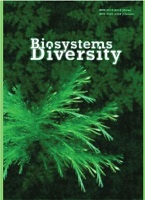Schistosomatidae from the trematode fauna of aquatic and semi-aquatic birds in Uzbekistan
Schistosomatidae from the trematode fauna of aquatic and semi-aquatic birds in Uzbekistan
Author(s): F. Akramova, U. Shakarbaev, I. Arepbaev, Z. Yorkulov, A. Ravshanova, S. Saidova, Dilmurod AzimovSubject(s): Environmental Geography, Environmental interactions
Published by: Дніпропетровський національний університет імені Олеся Гончара
Keywords: cercariae; molluscs; intermediate hosts; definitive hosts; cercariosis; Bilharziella; Trichobilharzia; Ornithobilharzia;Dendritobilharzia;Gigantobilharzia;
Summary/Abstract: The article discusses the infection of wetland birds in Uzbekistan with the trematodes Schistosomatidae Stiles et Hassall, 1898. The research covered 282 individuals from the main groups of birds represented by the orders Pelecaniformes, Ciconiformes, Anseriformes, Gruiformes, Podicipediformes and Charadriiformes. The Schistosomatidae fauna of Uzbekistan includes 13 species: Bilharziella polonica (Kowalewsky, 1895), Trichobilharzia ocellata (La Valette, 1854), T. filiformis (Szidat, 1938), T. kowalewskii(Ejsmont, 1929), T. tatianae (Spasskaja, 1953), Macrobilharzia macrobilharziaTrawassos, 1923, Ornithobilharzia canaliculata (Rudolphi, 1819), O. baeri Fain, 1955, Dendritobilharzia pulverulenta (Braun, 1901), D.loossiSkrjabin, 1924, D. anatinarum Cheatum, 1941, Gigantobilharzia acotylea Odhner, 1910 and Gigantobilharziella monocotylea (Szidat, 1930). Predominant are representatives of the genera Trichobilharzia and Dendritobilharzia. The species composition of Schistosomatidae is most diverse in birds from the lower reaches of the Amu Darya, where a high rate of infection with larvae of some of these trematodes was also recorded in aquatic molluscs. 11 species of molluscs were registered in the studied regions: Galba truncatula (Muller, 1774), Stagnicola corvus (Gmelin, 1791), Radix auricularia (Linnaeus, 1758), Lymnaea stagnalis (Linnaeus, 1758), Physa fontinalis(Linnaeus, 1758), Physella acuta (Draparnaud, 1805), Planorbis planorbis(Linnaeus, 1758), P. tangitarensis Germain, 1918, Anisus spirorbis (Linnaeus, 1758), Gyraulus albus (Muller, 1774), Melanoides kainarensis Starobogatov et Izzatullaev, 1980, from the families Lymnaeidae (4 species), Planorbidae (4 species), Physidae (2 species) and Thiaridae (1 species). They are identified as intermediate hosts of Schistosomatidae and were infected with 7 species of flukes. The total rate of infection with larval stages of Schistosomatidae in molluscs was about 2.0%. The highest infection rate was observed in Melanoides kainarensis – 5.3%. Morpho-biological indicators for mature forms of B. polonica from different bird species (Anas platyrhynchos and Oxyura leucocephala) were confirmed by molecular genetic studies. The study identified foci of birds’ infection with Schistosomatidae and the occurrence of human cercarial dermatitis.
Journal: Biosystems Diversity
- Issue Year: 31/2023
- Issue No: 1
- Page Range: 3-9
- Page Count: 7
- Language: English

